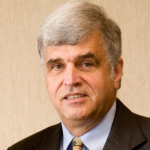Vision looms large in American history. John F. Kennedy’s took us to the moon. Ronald Reagan’s led to the end of the Soviet Union. Dwight D. Eisenhower’s produced the Interstate highway system, which has done so much to make this nation one and to fuel its unparalleled economic growth.
But in the increasingly politicized environment of America today, vision seems to have taken a long holiday. Until now.
Texas Governor Rick Perry’s TransTexas Corridor plan, which would build wholly new transportation networks throughout the state, is the first serious innovative thinking in transportation in a half-century. The Corridors would be wide rights-of-ways bypassing the metropolitan areas, providing expedited travel on separated truck and automobile roadways and capacity for freight and passenger rail. Most importantly, as state governments nationwide face severe funding challenges, the corridors would largely pay for themselves.
Texas, and indeed the rest of the nation, are long overdue for the Perry vision. The state is suffering from an inability to handle growing traffic congestion. To some degree, this is due to the influence of those who erroneously claim more highways create more traffic, on the assumption we sit around waiting for new roads to open so we can spend more time behind the wheel.
Traffic on the rise
Automobile use has increased in recent decades because populations who had less access to mobility in the past—women and minorities, for example—are improving their access. Progress is still required in auto ownership rates among minorities—which means driving will continue to increase more rapidly than population does. In a free and prosperous economy, this is as it should be.
Additional increases in traffic will be fueled by NAFTA-driven freight volumes, both by truck and rail. Under Perry’s plan for Texas, the truck traffic will be diverted to innovative “truckways,” separate lanes designed specifically for heavy trucks. The truckways will make the passenger vehicle lanes safer, less congested, and less stressful for regular traffic.
Freight rail traffic is expected to double or triple in the coming years. Perry’s Corridor plan will prevent additional rail-induced gridlock in communities already dissected by slow-moving freight rail lines.
How to pay for the plan?
And then there is the matter of money. There simply isn’t enough gas tax revenue available in Texas to build all the roads that are needed. It is time to bury the gas tax as a source of additional highway revenues. Virtually all of the highest-priority roadway expansion needs are in and around the state’s largest metropolitan areas … but politics simply will not permit spending all of the state’s gas tax revenues in just a few places.
If Texas is to make significant, long-term improvements to its transportation network, the state must adopt user-pay mechanisms, as Perry is proposing. Infrastructure companies will submit proposals to build corridors across the state and around the cities using tolls and rail access fees. Although large cost estimates are being tossed around, very little of the funding will come from the public treasury.
Perry’s plan is not without risk. Around the world are examples of both success and failure in infrastructure development. The Channel Tunnel (connecting England with the European continent) and new Denmark bridges, for example, are self-financing, requiring little or no government assistance. By contrast, high-speed rail projects in both Florida and Texas, advertised as self-financing, were abandoned after the firms reneged on their promises and sought significant government subsidies.
It will be important for Texans to distinguish carefully between serious infrastructure players who are prepared to take risks, and firms that have so often played “bait-and-switch” with taxpayer money. The TransTexas Corridor plan will need strong safeguards to ensure commitments are kept.
Legitimate concerns have also been raised about the viability of the passenger rail portions of the plan. Questioners would do well to remember the Perry plan is self-financing. If a private firm can figure out how to make money and provide passenger rail service, more power to it. The key, again, is to make sure the public vault is securely locked.
Governor Perry has articulated a vision that can transport Texas and its people to a better future. Skilled administration by the governor, legislature, and Texas Department of Transportation will help propel the state to economic preeminence and a higher standard of living for all. Other governors are likely to soon follow his lead.
Wendell Cox is a senior fellow of The Heartland Institute; a consultant to public and private public policy, planning, and transportation organizations; and a visiting professor at a French national university.




